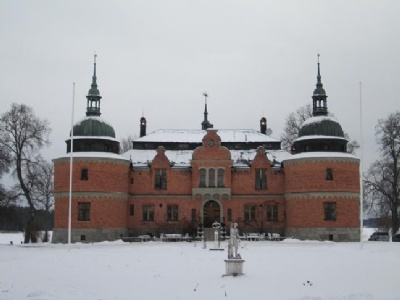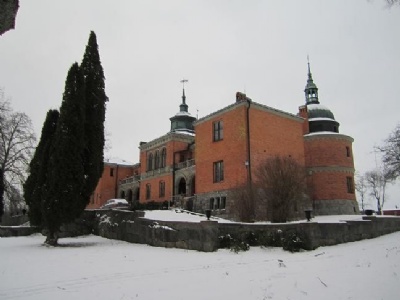Rockelstad Castle
In Södermanland County, about ten kilometres east of Flen, at the southern shores of Lake Båven is Rockelstad castle. The castle began to be built in the mid-1600s, but its current form dates back to the late 1800s when it was renovated. It is built in brick, in vasa style and is in comparison with many other castles quite small. In 1900, Count Eric von Rosen, took over the castle and it is through him that the castle has got its Nazi connection. On a Friday, February 20, 1920, Eric von Rosen was in Stockholm and was keen to travel home to Rockelstad, but a snowstorm made train travel impossible. Determined to travel home, von Rosen contacted the company Swedish Airtraffic and asked them if they could fly him to Rockelstad. A 27-year-old German pilot named Hermann Goering saw a chance to earn some extra money and accepted the request.
The plane landed at noon on Lake Båven’s ice just below the castle. The weather was about to turn into snowfall and von Rosen offered Goering to stay overnight at the castle. When von Rosen and Goering entered the castle, von Rosen presented Goering to the rest of the family, including his sister-in-law Carin von Kantzow (born Fock). Carin was four years older than Goering and married to officer Nils von Kantzow. But feelings arose immediately between them both and they began to meet secretly in Stockholm. When it became known in Swedish society that they were seeing eachother it was a scandal considering that Carin was married with children. But Carin left both husband and child to live with Goering, first in Sweden and then in Germany where they moved in 1921. Carin filed for divorce, but only in December 1922 Carin’s husband signed the divorce papers. Carin and Hermann married then in January 1923 in Stockholm. The marriage was repeated a month later in Germany, where the couple had moved. However, his son Thomas stayed with his father in Sweden. The couple lived in frugal conditions and Carin’s family sent money to them. However, Carin came to miss Sweden and her son terribly, but it was something she had to live with.
After the Nazi failed coup attempt in Munich, November 1923, the couple fled first to Austria and then to Italy. Goering had been badly injured and took morphine to relieve the pain, problem was that this made Goering addicted to morphine until he was arrested in 1945. In 1925, the couple returned to Sweden, where Goering’s morphine addiction caused his health deteriorate and was hospitalized with the help of Carin’s family. But the addicition had led to Goering becoming mentally unstable and was therefore put in a month for weaning at Långbro mental hospital. Goering, however, relapsed and voluntarily signed up twice at Långbro for weaning. Goering made his way through various jobs in Sweden and finally returned to Germany in 1927. Carin joined Goering at a later date. Over the years, her health detoriated and she suffered from a weak heart and died during a visit to Sweden in October, 1931.
Current status: Preserved (2010).
Location: 59° 2' 22 N 16° 51'25 E
Get there: Car.
Follow up in books: Willi, Frischauer: Goering (1950).



The castle is 2010 in private ownership but can be rented for events. When Goering became the second most pwerful man in the Third Reich, he kept in touch with Carin’s family, who until the outbreak of the Second World War often visited him in Germany. Both Eric and his brother Clarence were passionate about Nazism, and Clarence attended a Swedish delegation congratulating Hitler on his 50th birthday in 1939. When media in 2000 brought Clarence’s political (german) involvement into light, a debate arose as whether it was appropriate that the trophy that was handed out to the Swedish champions of football wore the name, von Rosen’s trophy. Clarence was the Swedish football association’s first chairman and the trophy was therefore named in Clarence’s memory. The decision was made to create a new trophy, named after another chairman, Lennart Johansson (Lennart Johansson Trophy), and since 2001 this trophy has been awarded the Swedish champions in football.